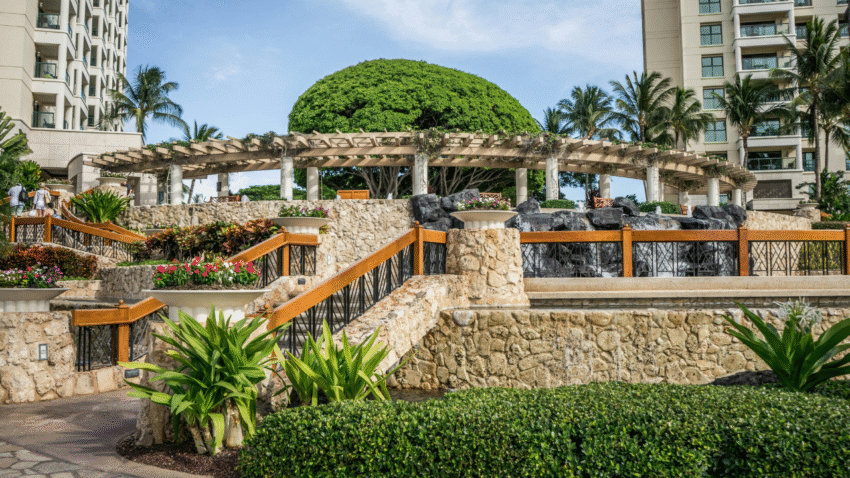Introduction
A beautiful patio adds charm and functionality to your outdoor living space, but without proper drainage, it can quickly become a soggy, slippery, and damaged mess. Learning how to plan drainage for a patio ensures that rainwater flows away smoothly instead of pooling on the surface or seeping into the foundation. If you’ve ever noticed puddles, shifting pavers, or muddy spots after a storm, it’s likely due to poor drainage. This guide will walk you through the steps to create a patio that stays dry, safe, and long-lasting.
Why Patio Drainage Matters
Water is one of the biggest enemies of patios. Without a proper drainage plan, you may face:
- Standing water: Puddles on the surface create slip hazards and damage finishes.
- Erosion: Water washing away soil under pavers or slabs can cause uneven surfaces.
- Weed and moss growth: Moist areas promote unwanted growth in joints.
- Foundation damage: Poor drainage can send water toward your home, leading to cracks or leaks.
By planning effective drainage, you’ll:
- Protect your patio’s structure and appearance.
- Reduce maintenance and repair costs.
- Improve safety for your family and guests.
- Ensure long-term durability in all weather conditions.
Step-by-Step Guide to Planning Drainage for a Patio
1. Assess the Patio Site
Before you design the patio or make upgrades, evaluate the site:
- Identify natural slopes in the yard.
- Look for low spots where water tends to pool.
- Check how close the patio will be to your home’s foundation.
Tip: A patio should always slope away from the house to keep water from seeping into the basement or foundation.
2. Choose the Right Patio Slope
The most important part of patio drainage is setting the correct slope.
- Standard recommendation: 1/8 to 1/4 inch per foot of slope away from the home.
- For a 10-foot patio, this means a total drop of 1–2.5 inches.
- Use a string line or level during construction to measure the grade accurately.
This simple step ensures gravity does most of the drainage work for you.
3. Select a Suitable Base Material
The foundation beneath your patio plays a big role in drainage.
- Gravel base: Provides stability and allows water to filter through.
- Sand layer: Helps even out the surface and supports pavers.
- Permeable pavers: Allow rainwater to pass directly through into the ground.
Avoid laying pavers directly on soil, as it promotes uneven settling and poor drainage.
4. Install Drainage Channels or Pipes
For patios in high-rainfall areas or on flat ground, additional drainage may be necessary. Options include:
- French drains: Trenches filled with gravel and a perforated pipe to redirect water.
- Channel drains: Long, narrow drains installed at the edge of patios to collect surface water.
- Dry wells: Underground reservoirs that collect excess water and allow it to slowly disperse into the soil.
Pro Tip: Place French drains along the lowest edge of the patio to capture runoff efficiently.
5. Consider Drainage Grates and Covers
Where drains are visible, install durable grates to keep leaves, dirt, and debris from clogging the system. Choose metal or heavy-duty plastic grates designed for outdoor use.
6. Direct Water Away From the Home
The ultimate goal of any drainage system is to move water away from structures. Make sure:
- Downspouts are extended to discharge water beyond the patio.
- Drainage pipes lead to safe outlets like gardens, gravel pits, or storm drains.
- Water does not pool in other parts of the yard, creating new problems.
7. Test the Drainage System
After construction, test your drainage plan by spraying the patio with a hose or observing it during rainfall. Look for:
- Proper water flow off the surface.
- No pooling in joints or corners.
- Smooth water movement toward drains or outflow areas.
Adjust slopes or drainage channels if water still collects in unwanted areas.
Common Mistakes to Avoid
- Mistake: Building a level patio.
Solution: Always create a slight slope to direct water flow. - Mistake: Using soil instead of gravel base.
Solution: Install a compacted gravel base for proper drainage and stability. - Mistake: Forgetting to extend downspouts.
Solution: Redirect roof runoff away from your patio area. - Mistake: Installing drains without grates.
Solution: Always cover drains to prevent clogging. - Mistake: Directing water toward the house.
Solution: Ensure all slopes and drains move water away from foundations.
Extra Patio & Deck Tips & Hacks
- Permeable Pavers: These are an eco-friendly option that allow rainwater to pass through instead of running off.
- Seasonal Maintenance: Clear leaves and debris from drains each fall to prevent clogs.
- Edge Protection: Add edging stones or borders to keep joint sand and base material in place during heavy rains.
- Related Guide: Learn more about keeping patios strong with our article on How to Protect a Stone Patio from Ice Damage.
Conclusion
Planning drainage for a patio is just as important as choosing the right materials or design. With a proper slope, solid base, and effective drainage channels, you can prevent standing water, erosion, and costly damage. A little planning before construction—or retrofitting an existing patio—will keep your outdoor living space dry, safe, and enjoyable in all weather conditions.
Don’t overlook drainage—make it part of your patio plan, and you’ll enjoy years of low-maintenance outdoor comfort.
